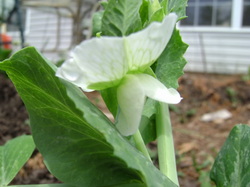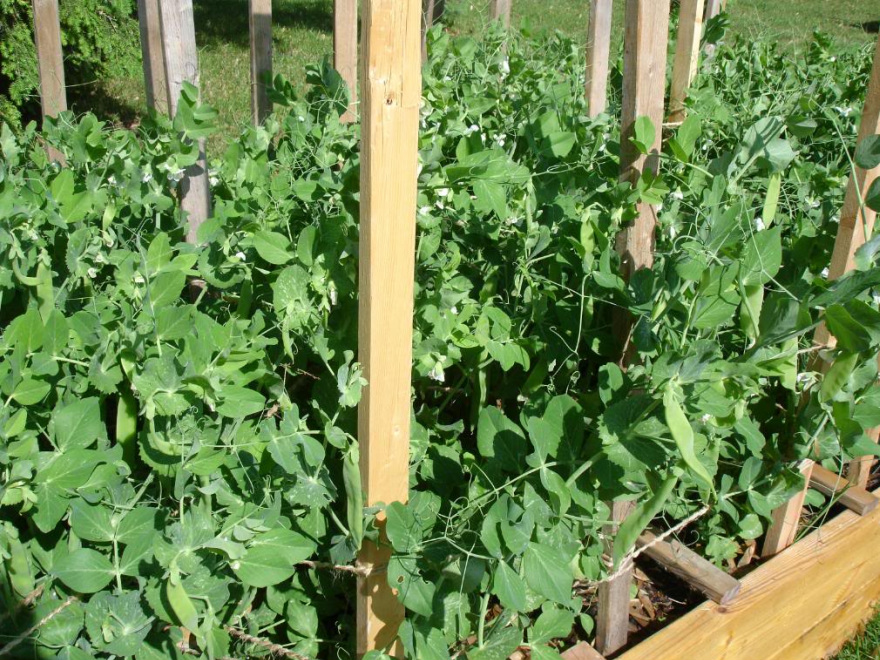Growing Sweet Sugar, Snap, & Snow Peas In Your Organic Garden

BEST LOCATIONS FOR PLANTING
In the spring plant your peas in full sun protected from strong winds.
Later plantings will benefit from some shade from the afternoon heat. Planting next to taller plants, such as corn, can provide that protection during the hot part of the day.
It is essential to keep your pea roots from over-heating. When weather begins to warm, apply 2" of mulch around the roots. The mulch will keep peas cooler and prolong your season.
Lower growing bush varieties can be grown in containers with attention to the soils moisture levels. Watering will be more frequent.
PLANTING TIME
Peas can be planted as soon as the ground is workable and the soil temperature has reached at least 40 F.
Pea plants can survive frost and temperatures down to the lower 20’s but are susceptible when emerging from soil and during bloom.
PREPARING YOUR GARDEN
PH level: 6.0-6.7
Cool weather is not a concern for growing peas. Soil condition, however is.
Preparing your garden's soil for growing peas should start in the fall by spading or tilling plenty of leaves and other organic material into the soil.
When the weather gets wet in the fall, these organic materials will decay quickly.
In spring you will be left with rich, loose soil, aiding in root development and providing good drainage.
For early plantings, elevating the rows (raised beds) will retain heat in those cool early spring days and also help drain any excess moisture.
Peas are of the legume family and therefore supply their own nitrogen.
Don't use high nitrogen organic fertilizers such as manure. Too much nitrogen will produce beautiful, dense foliage but very few peas.
SEEDS AND GERMINATION
Seeds will germinate at soil temperatures as low as 40F in approximately 36 days. With soil temperatures at 60 F, germination will accelerate to 7-10 days.
Pre-soak seeds in water for 24 hours to soften the hard seed coating, drain, and spray with an organic seaweed emulsion before planting.
Seed will remain plantable for up to viability 3 years.
GETTING STARTED INDOORS (transplanting)
Not Recommended: Pea roots are very delicate and often do not survive transplanting. Peas are also tough in cool weather, so starting seedlings indoors is not necessary.
PLANTING AND GROWING (Planting seeds directly into the garden)
Peas are prone to rot and susceptible to fungus attack. When planting untreated organic seeds (seeds that have not been sprayed with a fungicide) plant a bit heavier to cover for any losses.
If you aren't sure whether your seeds have been treated, it's pretty easy to tell. If they have a pink coating, they have been treated.
Space your untreated seeds 1.5” apart (2” for treated seeds).
Plant early crops 2” deep in light soil, 1” in heavy soil.
Increase seed depth 1-2 inches deeper as the weather warms up. This will keep the seeds cooler and prolong your season.
If planting where legumes have not been planted before, treat pea seeds with an inoculant powder by soaking seeds.
After soaking, drain seeds and sprinkle a light coating of powder on top. Swirl around in bowl to lightly coat seeds. Plant immediately.
This year we applied an outstanding plant extract leaf spray once every two weeks, making vibrant plants that produced a lot of really sweet peas!
WATERING
Peas should never be in waterlogged soil.
Consistent and moderate watering is your best option for growing peas. This is critical when blooms are forming. Too much water will reduce yields and potentially rot the roots.
COMPANION PLANTING & ROTATION
To best utilize your garden space, inter-plant peas with spinach, lettuce, or radishes. Bad companions include all members of the onion/garlic family.
Rotation consideration: Follow peas with corn because of the nitrogen-fixing qualities of pea plants when tilled in after the harvest.
WHEN TO HARVEST
Pea pods are usually ready to pick about three weeks after blossoming.
Sugar peas (also known as Snow Peas) are harvested when they are flat and the peas are barely noticeable.
Snap peas are more versatile. They can be harvested when the pod is young and flat or later once the peas are big and plump in the pod.
Cut off pods with scissors rather than pull them. Pulling the pods can uproot the plant or cause shock to the plant which will halt production.
Harvesting on a daily basis will not only allow you to pick the peas when they are prime but it triggers the plants to keep producing.
STORAGE
For storage, freeze your peas within a few hours of harvest to preserve freshness. If you allow peas to keep more than a day in the refrigerator, the sugar quickly turns to starch.
COMMON PESTS AND PROBLEMS
Most problems growing peas can be avoided by correct watering and not allowing the soil to become waterlogged.
Powdery mildew can be an issue when the weather warms. Your plants will appear flocked; this white fungal coat will drain all nutrients out of the leaves.
Apply sulfur dust to the foliage early in the season as a preventative.
Aphids can cause mosaic virus in your peas which causes the plant to yellow and become stunted. Insecticidal soap is effective for this. It will also help with thrips, a tiny dark colored insect found on the underside of a leaf that distorts and eventually kills the leaf.
The Pea Weevil, a tiny brown beetle with white spots will bore an opening in the blossom and lay eggs in the pods. Eventually they will damage the pea. Crop rotation will help discourage this pest, but if the problems get out of control, use Pyrethrins.
In the spring plant your peas in full sun protected from strong winds.
Later plantings will benefit from some shade from the afternoon heat. Planting next to taller plants, such as corn, can provide that protection during the hot part of the day.
It is essential to keep your pea roots from over-heating. When weather begins to warm, apply 2" of mulch around the roots. The mulch will keep peas cooler and prolong your season.
Lower growing bush varieties can be grown in containers with attention to the soils moisture levels. Watering will be more frequent.
PLANTING TIME
Peas can be planted as soon as the ground is workable and the soil temperature has reached at least 40 F.
Pea plants can survive frost and temperatures down to the lower 20’s but are susceptible when emerging from soil and during bloom.
PREPARING YOUR GARDEN
PH level: 6.0-6.7
Cool weather is not a concern for growing peas. Soil condition, however is.
Preparing your garden's soil for growing peas should start in the fall by spading or tilling plenty of leaves and other organic material into the soil.
When the weather gets wet in the fall, these organic materials will decay quickly.
In spring you will be left with rich, loose soil, aiding in root development and providing good drainage.
For early plantings, elevating the rows (raised beds) will retain heat in those cool early spring days and also help drain any excess moisture.
Peas are of the legume family and therefore supply their own nitrogen.
Don't use high nitrogen organic fertilizers such as manure. Too much nitrogen will produce beautiful, dense foliage but very few peas.
SEEDS AND GERMINATION
Seeds will germinate at soil temperatures as low as 40F in approximately 36 days. With soil temperatures at 60 F, germination will accelerate to 7-10 days.
Pre-soak seeds in water for 24 hours to soften the hard seed coating, drain, and spray with an organic seaweed emulsion before planting.
Seed will remain plantable for up to viability 3 years.
GETTING STARTED INDOORS (transplanting)
Not Recommended: Pea roots are very delicate and often do not survive transplanting. Peas are also tough in cool weather, so starting seedlings indoors is not necessary.
PLANTING AND GROWING (Planting seeds directly into the garden)
Peas are prone to rot and susceptible to fungus attack. When planting untreated organic seeds (seeds that have not been sprayed with a fungicide) plant a bit heavier to cover for any losses.
If you aren't sure whether your seeds have been treated, it's pretty easy to tell. If they have a pink coating, they have been treated.
Space your untreated seeds 1.5” apart (2” for treated seeds).
Plant early crops 2” deep in light soil, 1” in heavy soil.
Increase seed depth 1-2 inches deeper as the weather warms up. This will keep the seeds cooler and prolong your season.
If planting where legumes have not been planted before, treat pea seeds with an inoculant powder by soaking seeds.
After soaking, drain seeds and sprinkle a light coating of powder on top. Swirl around in bowl to lightly coat seeds. Plant immediately.
This year we applied an outstanding plant extract leaf spray once every two weeks, making vibrant plants that produced a lot of really sweet peas!
WATERING
Peas should never be in waterlogged soil.
Consistent and moderate watering is your best option for growing peas. This is critical when blooms are forming. Too much water will reduce yields and potentially rot the roots.
COMPANION PLANTING & ROTATION
To best utilize your garden space, inter-plant peas with spinach, lettuce, or radishes. Bad companions include all members of the onion/garlic family.
Rotation consideration: Follow peas with corn because of the nitrogen-fixing qualities of pea plants when tilled in after the harvest.
WHEN TO HARVEST
Pea pods are usually ready to pick about three weeks after blossoming.
Sugar peas (also known as Snow Peas) are harvested when they are flat and the peas are barely noticeable.
Snap peas are more versatile. They can be harvested when the pod is young and flat or later once the peas are big and plump in the pod.
Cut off pods with scissors rather than pull them. Pulling the pods can uproot the plant or cause shock to the plant which will halt production.
Harvesting on a daily basis will not only allow you to pick the peas when they are prime but it triggers the plants to keep producing.
STORAGE
For storage, freeze your peas within a few hours of harvest to preserve freshness. If you allow peas to keep more than a day in the refrigerator, the sugar quickly turns to starch.
COMMON PESTS AND PROBLEMS
Most problems growing peas can be avoided by correct watering and not allowing the soil to become waterlogged.
Powdery mildew can be an issue when the weather warms. Your plants will appear flocked; this white fungal coat will drain all nutrients out of the leaves.
Apply sulfur dust to the foliage early in the season as a preventative.
Aphids can cause mosaic virus in your peas which causes the plant to yellow and become stunted. Insecticidal soap is effective for this. It will also help with thrips, a tiny dark colored insect found on the underside of a leaf that distorts and eventually kills the leaf.
The Pea Weevil, a tiny brown beetle with white spots will bore an opening in the blossom and lay eggs in the pods. Eventually they will damage the pea. Crop rotation will help discourage this pest, but if the problems get out of control, use Pyrethrins.

